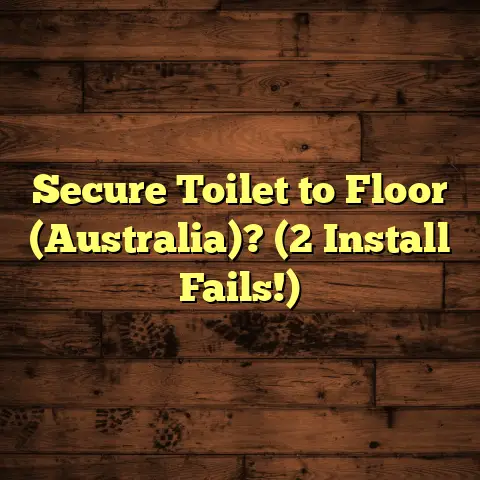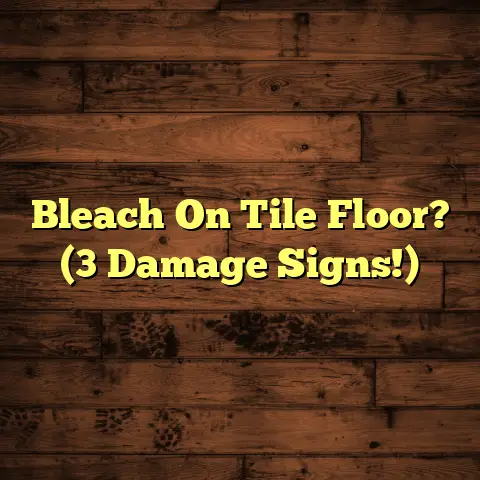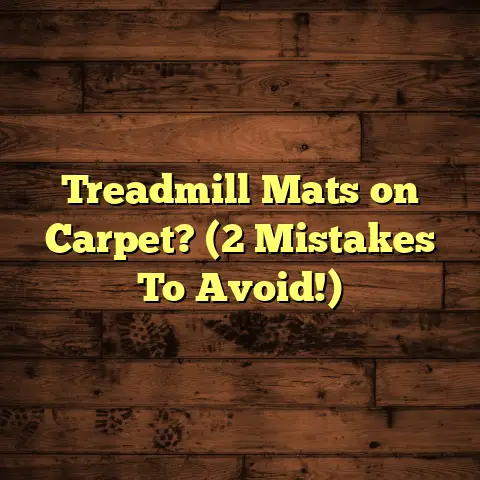Perfect Quarter Round Choice? (7 Install Tips!)
I’m going to let you in on a little secret:
Quarter round gets a bad rap.
A lot of folks think it’s just a decorative afterthought, something you slap on to make your floor look “finished.”
But trust me, after years in this business, I can tell you that quarter round is way more important than you think.
It’s not just about aesthetics; it’s about protection, transition, and the overall longevity of your floor.
So, let’s dive in and debunk this myth once and for all!
Section 1: Understanding Quarter Round
So, what is quarter round, exactly?
Basically, it’s a small, rounded molding that you install along the base of your walls where they meet the floor.
It’s called “quarter round” because, well, it looks like
a quarter of a circle.
Pretty straightforward, right?
You’ll typically find it made from these materials:
- Wood: Classic, paintable, stainable, and comes in various wood types like oak, pine, maple, etc.
- PVC: Waterproof, great for bathrooms and kitchens, and resistant to rot and pests.
- MDF (Medium-Density Fiberboard): Affordable, smooth, and easy to paint, but not ideal for wet areas.
Now, here’s where things get interesting.
Quarter round comes in a ton of styles and finishes.
You’ve got your basic, unpainted wood that you can customize, pre-finished options that match popular flooring colors, and even decorative profiles that add a little extra flair.
But why do we even need it?
Well, for starters, it covers the expansion gap that’s left when you install floating floors like laminate or hardwood.
These floors need room to expand and contract with changes
in temperature and humidity.
Without that gap, they can buckle.
Quarter round hides that gap and also:
- Protects your walls from getting scuffed and damaged by shoes, furniture, and vacuum cleaners.
- Creates a barrier against moisture and dirt, preventing it from seeping under your baseboards and causing mold.
- Provides a clean, finished look to your flooring project, making the transition between the floor and wall seamless.
I’ve used quarter round with pretty much every type of flooring you can imagine: hardwood, laminate, tile, vinyl.
It always makes a difference, both in terms of appearance and how well the floor holds up over time.
Section 2: Choosing the Right Quarter Round
Okay, so you’re convinced that quarter round is important.
Now, how do you pick the right one for your project?
Here are a few key factors to consider:
- Material Compatibility: If you’re installing hardwood
flooring, you’ll probably want to stick with wood quarter
round for a cohesive look.
For bathrooms, PVC is the way to go. - Color Matching: This is crucial.
You want your quarter round to either blend seamlessly with your baseboards or complement your flooring.
Bring a sample of your flooring or baseboard to the store to find the perfect match. - Durability: Think about the traffic in the area where
you’re installing the quarter round.
High-traffic areas might benefit from a more durable material like solid wood. - Aesthetics: Do you want a simple, understated look, or
something with a little more detail?
Consider the overall style of your room and choose a quarter round that fits.
Let’s talk about the pros and cons of different materials:
Source: Experienced opinion after 15 years in the business
I’ve seen homeowners try to save a few bucks by going with cheap MDF in a bathroom, and it’s never a good idea.
Trust me, the extra cost of PVC is worth it in the long run.
Finally, let’s talk about measuring.
Before you even head to the store, you need to measure the perimeter of the room where you’ll be installing the quarter round.
Add up the length of all the walls and then add an extra 10% to account for waste and mistakes.
It’s always better to have too much than not enough.
Pro Tip: When measuring, be as precise as possible.
Round up to the nearest inch.
Section 3: Preparing for Installation
Alright, you’ve got your quarter round.
Now it’s time to get ready for installation.
Here are the tools you’ll need:
- Miter Saw: For making accurate angle cuts. A must-have for corners!
- Nail Gun: Makes quick work of attaching the quarter
round to the baseboards.
If you don’t have one, you can use a hammer and finishing nails, but it’ll take longer. - Measuring Tape: For, well, measuring.
- Pencil: For marking your cuts.
- Caulk Gun: For applying caulk to fill any gaps.
- Safety Glasses: Protect your eyes!
- Dust Mask: Especially important if you’re cutting MDF.
Make sure your tools are in good working condition before
you start.
Sharpen your saw blade, check your nail gun for
any jams, and load up your caulk gun.
Next, you’ll need to prep the surface.
This means cleaning the area where you’ll be installing the
quarter round.
Vacuum up any dust, dirt, or debris.
Make sure the walls are level and free from any obstructions.
If you have any loose baseboards, now’s the time to fix them.
Finally, and this is important:
Acclimate the quarter round to the room’s temperature and humidity for at least 24 hours before installation.
This will prevent it from warping or shrinking after you install it.
I’ve made the mistake of skipping this step before, and I can tell you, it’s not worth the hassle.
Just leave the quarter round in the room where you’ll be installing it and let it adjust.
Section 4: 7 Install Tips for Perfect Quarter Round Application
Okay, let’s get to the good stuff!
Here are my top 7 tips for a perfect quarter round installation:
1. Tip 1: Measure Twice, Cut Once
This is the golden rule of woodworking, and it applies to quarter round as well.
Before you make any cuts, double-check your measurements.
It’s easy to make a mistake, and a miscut piece of quarter round is just wasted material.
When cutting corners, you’ll need to use your miter saw to make 45-degree angle cuts.
Pro Tip: Practice your cuts on scrap pieces of quarter round before you start on the real thing.
2. Tip 2: Use the Right Adhesive
Adhesive can be your best friend when installing quarter round.
It helps to hold the molding in place while you nail it, and it can also fill any small gaps between the quarter round and the baseboard.
For wood quarter round, use a wood glue or construction adhesive.
For PVC, use a PVC adhesive.
Make sure the adhesive you choose is compatible with the materials you’re working with.
I prefer to apply a bead of adhesive to the back of the quarter round before I nail it in place.
3. Tip 3: Nail Placement
Nailing is crucial for securing the quarter round.
You want to use finishing nails that are long enough to penetrate the quarter round and the baseboard, but not so long that they go through the wall.
I typically use 1 1/4″ or 1 1/2″ finishing nails.
Space your nails about 12-16 inches apart, and be sure to drive them in straight.
Pro Tip: Use a nail set to countersink the nails slightly
below the surface of the quarter round.
This will make it
easier to fill the nail holes with wood filler later on.
4. Tip 4: Caulking for a Seamless Finish
Caulk is your secret weapon for creating a professional-looking quarter round installation.
Apply a bead of caulk along the top edge of the quarter round, where it meets the baseboard.
This will fill any gaps and create a smooth, seamless transition.
Use a paintable caulk so you can touch it up later on.
Pro Tip: Use a wet finger or a damp cloth to smooth out
the caulk after you apply it.
This will give you a clean,
professional finish.
5. Tip 5: Paint or Stain Before Installation
If you’re planning on painting or staining your quarter round, it’s much easier to do it before you install it.
This will save you a lot of time and effort, and it will also give you a more even finish.
Plus, you won’t have to worry about getting paint or stain on your walls or floors.
Pro Tip: Apply a primer before you paint or stain your
quarter round.
This will help the paint or stain adhere better
and give you a more durable finish.
6. Tip 6: Allow for Expansion
Remember that expansion gap we talked about earlier?
It’s important to leave a small gap between the quarter round and the flooring to allow for expansion and contraction.
I usually leave a gap of about 1/8″ to 1/4″.
You can use shims to create this gap while you’re installing the quarter round.
Pro Tip: Don’t caulk the bottom edge of the quarter round.
This will prevent the flooring from expanding and contracting
properly.
7. Tip 7: Clean Up and Maintenance
Once you’ve finished installing your quarter round, it’s time to clean up.
Remove any dust, dirt, or debris from the area.
Fill any nail holes with wood filler and sand them smooth.
Touch up any paint or stain as needed.
To maintain your quarter round, simply wipe it down with a damp cloth on a regular basis.
Pro Tip: Avoid using harsh chemicals or abrasive cleaners
on your quarter round.
These can damage the finish.
Conclusion: Recap and Reinforce Importance
So, there you have it!
My top 7 tips for a perfect quarter round installation.
Remember, choosing the right quarter round and following proper installation techniques can make a huge difference in the overall look and longevity of your flooring.
Don’t underestimate the importance of this seemingly small detail.
With a little bit of planning and effort, you can achieve a professional-looking finish that will protect your walls, hide your expansion gap, and enhance the beauty of your floors for years to come.
Now go out there and get installing!





